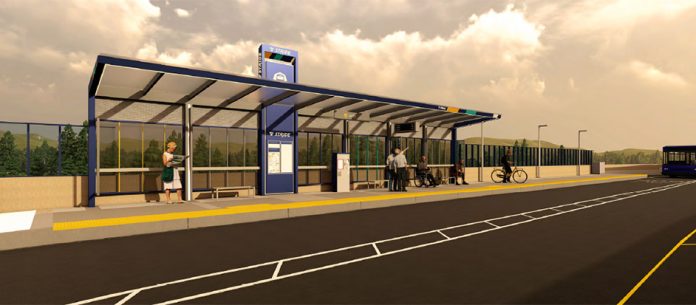The arrival of Stride, Sound Transit’s bus rapid transit (BRT) brand, on I-405 is still four years away, but recent project refinements could mean even speedier trips for riders travelling between Lynnwood and Bellevue. The transit agency published another online open house last week highlighting the progress. The proposed changes could wind up saving riders an extra 13 minutes during the morning peak hours compared to the proposal early last year which had already identified four minutes in savings over the baseline representative project.
Travel time savings come from the use of inline BRT stations built into the highway median. This is made possible by an I-405 highway expansion project that the Washington State Department of Transportation (WSDOT) is pursuing and for which funding was secured from the Washington State Legislature last year. Highway expansion from SR-527 to SR-522 will mean the addition of one express toll lane (ETL) in each direction at a cost of $600 million.

Cumulatively as part of the Stride program, riders travelling from Lynnwood to Bellevue in the morning peak hours could save 19 to 24 minutes in travel time compared to trips today. Likewise, riders from Burien to Bellevue are projected to save 13 to 17 minutes in the morning peak. Riders will also benefit from higher quality buses and stations as well as more frequent buses, which are anticipated to come every 10 minutes during peak hours and every 15 minutes in the off-peak. Span of service is also expected to be 19 hours a day on weekdays and Saturdays and 17 hours on Sundays.
Setting aside the obvious and substantially negative environmental, social, and land use implications from highway expansion on I-405, the WSDOT project will allow Sound Transit to piggyback by installing inline bus stations at Canyon Park, UW Bothell/Cascadia College, and Brickyard rather than exiting and reentering the highway at traditional off- and on-ramps. Totem Lake/Kingsgate already has inline bus stops accessible from the existing ETLs and NE 85th St had already been planned for inline bus stops as part of the interchange reconstruction.

Reconstruction of the NE 85th St interchange will certainly be a centerpiece of WSDOT’s ETL expansion program on I-405. Costs for the project are estimated to be north of $260 million and involve a three-level interchange. ETLs would have access to a mid-level roundabout below I-405 and connect to NE 85th St below the roundabout via ramps. Bus stops would essentially be located at the mid-level so that riders can transfer between Stride and local buses easily. Stride buses, of course, would also be able re-enter I-405 quickly, presuming the roundabout does not routinely bunch up in a standstill.

At the Canyon Park, Sound Transit had planned to make off-ramp and intersection improvements to facilitate the installation of new stations near the overpass crossing. However, the revised plans would place stops in the center of I-405 reached by new direct access ramps from the ETLs, allowing for connections to the SR-527 overpass. This will continue to allow riders to reach local destinations and connect with nearby bus routes, including Swift at Canyon Park Park-and-Ride.
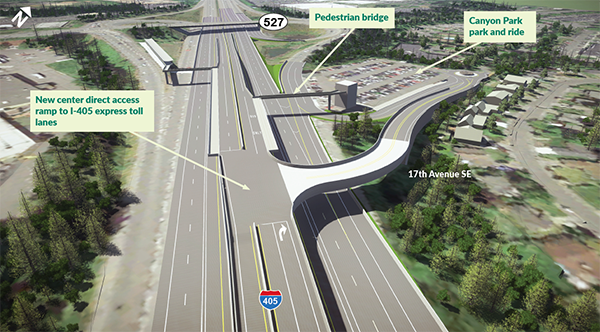
A similar direct access ramp from the ELTs is the plan for UW Bothell/Cascadia College. Sound Transit had originally conceived installation of off- and on-ramp stops at NE 195th St. However, the refined project may mean moving those stops further south to the SR-522/I-405 interchange, which would save time and arguably allow better connections to the planned SR-522 Stride line it would share the stops. Connections to the university and college actually may be slightly better, at least from a walking and biking standpoint, since the Sammamish River Trail—which effectively is a continuation of the Burke-Gilman and North Creek Trails—runs underneath the interchange and has direction access to the campus.
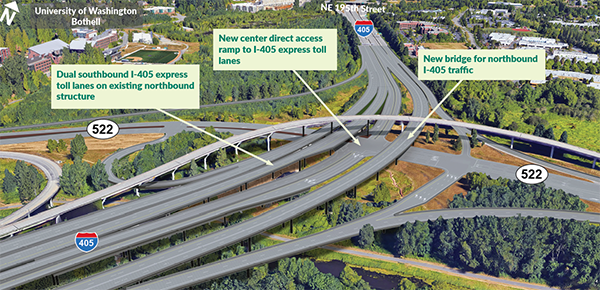
For the Brickyard station, the stops would be strictly located within the median using slip lanes from the ETLs. Pedestrian access would need to be added to the park-and-ride west of I-405, presumably by a pedestrian bridge or a connection to the Juanita-Woodinville Way NE overpass. The latter might be a bit more circuitous to the park-and-ride, but it would provide connections to denser residential to the east of I-405.
Sound Transit has not yet identified any additional costs for these inline bus stop additions, but they are presumably a minimal difference over the baseline project given that WSDOT is the primary project sponsor for the ETLs.
Not all station locations got notable refinements in the latest update, include Lynnwood Transit Center, Totem Lake/Kingsgate, Tukwila International Boulevard, and NE 44th St.
Last year, Sound Transit committed to constructing a station at Lynnwood Transit Center to allow for easy transfers between Central and East Link, Swift Orange Line, and local and express commuter bus routes. The light rail extension and Swift line should open in time to connect with Stride. The routing chosen between I-405 and Lynnwood Transit Center will involve running buses along I-5, 44th Ave W, 196th St SW, and Poplar Way. Strategic right-of-way improvements will be made to 44th Ave W and Poplar Way to speed up buses. Sound Transit is also coordinating with the City of Lynnwood to adjust signal to prioritize bus movements through intersections.
For the remainder of the Lynnwood-Bellevue Stride line, Sound Transit plans to stick with the existing direct access ramp at Totem Lake/Kingsgate for bus stops and using direct access to reach transit center in Downtown Bellevue. Riders will be able to connect with East Link, several RapidRide lines, and many local bus routes at the transit center. The transit center will also be the meeting point for the southern Stride line running from Burien to Downtown Bellevue via SR-518 and I-405.
On the Burien-Bellevue Stride line, Sound Transit also appears to be staying the course with a station at Burien Transit Center and freeway stations for the Tukwila International Boulevard and NE 44th St stations. Burien will benefit from a high occupancy vehicle (HOV) lane in the eastbound direction on SW 148th St for several blocks to reach SR-518 and a one-block westbound HOV lane to prioritize access to the transit center on SW 148th St.
At the Tukwila International Boulevard station, the bus stops will be on the right side of SR-518 and require the bus to loop off and back onto the highway. New improvements would be made to off- and on-ramps to accommodate bus movements and a pedestrian bridge will be constructed to access the southern stop so as to aid with connections to the light rail station. NE 44th St, however, will include inline bus stops since a direct access ramp is being installed as part of new ETLs. The station will include a new park-and-ride facility to provide 200 parking stalls.
More details are now known for the South Renton station. Sound Transit has a conceptual layout for several lots that the agency recently acquired from automotive companies. A new transit center with bus bays, bus layover space, and passenger amenities would be constructed just north of S Grady Way and east of Rainier Ave S.
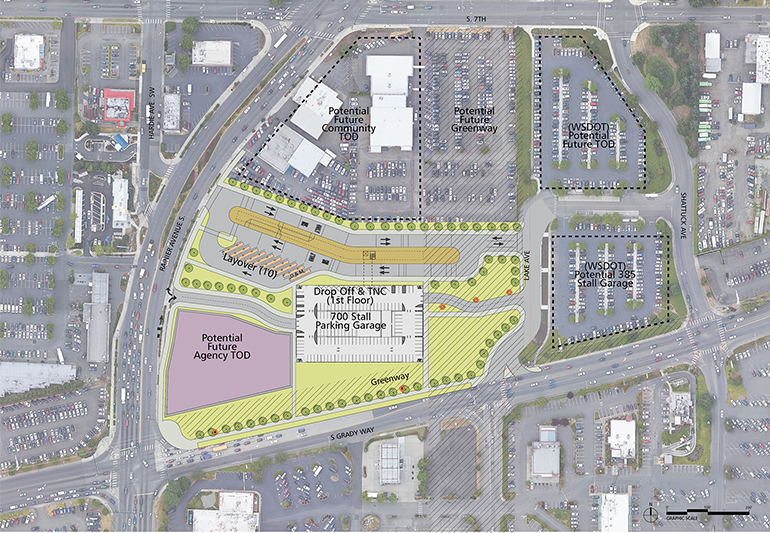
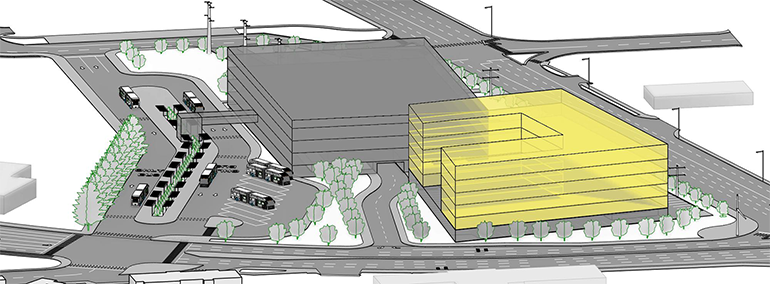
The Sound Transit site would complement the existing South Renton Park-and-Ride facilities just to the east of the site. One of the parking lots serving that facility would be retained for 385-stall parking garage while the other could be freed up for transit-oriented development (TOD). The Sound Transit site, for its part, would involve construction of a 700-stall parking garage and a consequential TOD project. The TOD would be located near the main intersection, which could eventually grow to be a gateway to Downtown Renton.
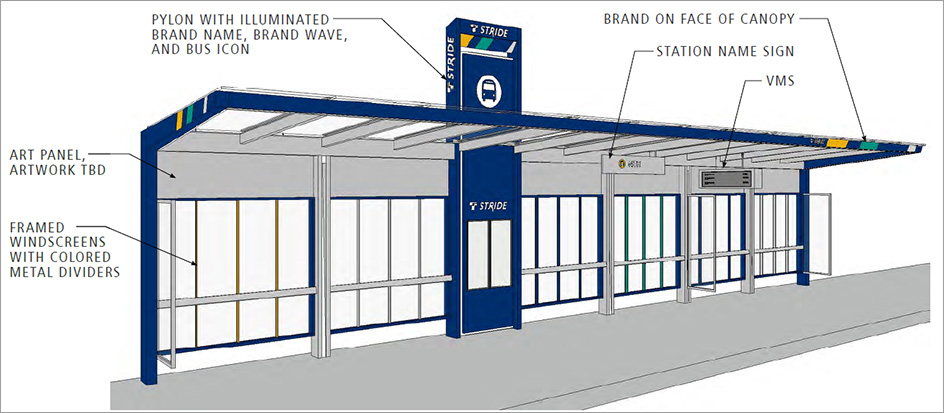
Sound Transit’s open house also highlights new renderings of the type of stations that could end up on streets for Stride. An interactive 360 degree preview is available as part of this. What the renderings show though is a slightly lighter design than used by King County Metro for RapidRide and Community Transit for Swift. Station canopies and windshields are shown to be long and tall. Illuminated Stride totems would be located near the center of the transit shelter to visibly identify the station and BRT services stopping at the station. Totems would also serve to provide information with maps and how to ride transit. Several other features stand out in the renderings, including:
- Lean rails along the length of the stations and two low benches;
- Ticket vending machines near the center of the stations;
- Branding colors matching BRT service serving the station would be highlighted on canopy faces on both station ends as well as on the front for easy rider identification;
- A hanging real-time arrival information sign; and
- A hanging station name sign.
Sound Transit also appears to be leaving space above the windows for local artwork to be featured.
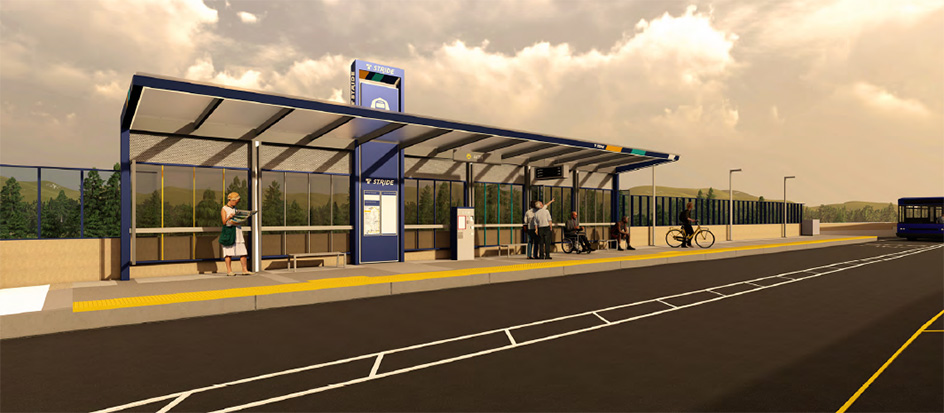
Overall, the station design is a big improvement over many others currently in use across the region. But the aesthetic qualities still feel utilitarian and dated. The design also could leave much to be desired on windy, rainy, and cold days with riders hunkered down to escape the elements. It is readily apparent that there is a concerted effort to make the stations feel welcoming, spacious, and secure with the elongated and high canopy design, but this still seems to fall well short of other priorities for basic comfort from the elements. Designers would be wise to rethink the design and seek best practices from abroad.
The online open house will be available through February 14th. A survey and comment section are included in the online open house. The project will soon move into the environmental review process to complete the State Environmental Policy Act and National Environmental Policy Act requirements. Given the scope of the project, it is not likely to require a full environmental impact statement, so the environmental review process should be relatively short wrapping up in the course of this year.
Stephen is a professional urban planner in Puget Sound with a passion for sustainable, livable, and diverse cities. He is especially interested in how policies, regulations, and programs can promote positive outcomes for communities. With stints in great cities like Bellingham and Cork, Stephen currently lives in Seattle. He primarily covers land use and transportation issues and has been with The Urbanist since 2014.


